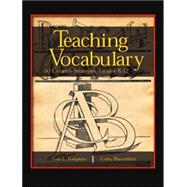
| Teaching Vocabulary Creatively | |
| Collecting Words | |
| Mastering Words: Making the Most of a Word Wall | |
| Personal Word Walls | |
| Thematic Word Walls | |
| Creating Science Journals | |
| Vocabulary Building: Sometimes Less is More | |
| Animal, Vegetable, or Mineral | |
| Disastrous Words | |
| Vocabulary Graphics | |
| Sorting for Success | |
| Vocabulary Squares | |
| Parts of Speech Word Wall | |
| Discovering Definition | |
| Word Expert | |
| Second Graders Make Personal Thesauruses | |
| Vocabulary Self-Check | |
| Vocabulary Discussions in Literary Circles | |
| Using Computer Software Tools to Expand Vocabulary | |
| Literary Terms | |
| Vocabulary Tea Party | |
| Vocabulary Carousel: A Merry-Go-Round of Words | |
| Using Meaningful Concepts to Understand Science Vocabulary | |
| Working With Meanings | |
| Which Meaning Should I Choose? Key Word Collection: A New Way to Focus on Multiple Meanings of Words | |
| Word Posters That Link Key Concepts | |
| Vocabulary Development in the Science Classroom | |
| Sensitizing Students to Shades of Meaning: The Synonym Continuum | |
| Connotations: Eclectic and Electric | |
| Venerable Teaching | |
| Shades of Meaning: Relating and Expanding Word Knowledge | |
| Expanding Writing Vocabulary | |
| Collecting Verbs for Revising Writing | |
| Learning the ABC's | |
| Nurturing My Students' Romance With Words | |
| Integrating Creative Verbs into Student Writing | |
| Recipe for Vocabulary Short Story Three-Layer Cake with Chocolate Frosting | |
| The Excitement of Words | |
| Curriculum-Related Word Banks: Deposits That Draw Interest | |
| Monster Sentences | |
| Don't Read This | |
| It's Taboo | |
| Investigating Word Origins | |
| Where In the World? From Slang to Dictionary Entry: A Word Study Project | |
| Back to Our Word Roots | |
| Start Your Day With Vocabulary: It's Low in Fat and High in Fiber | |
| Word Tree Posters | |
| Linking the Past With the Present: Modernizing Words | |
| Playing With Words | |
| Logcreatology | |
| Curing Homophone Madness | |
| Building Vocabulary and Comprehension Through Dramatization | |
| Vocabulary Poetry: A Means of Assessment | |
| Word Clusters: Exploring the Multiple Meanings of Words | |
| Vocabulary Crosswords | |
| Vocabulary Crib Books | |
| A Further Word | |
| You Will Thank Me for This Some Day: A Reflection on Direct Vocabulary Instruction | |
| About the Authors | |
| Table of Contents provided by Publisher. All Rights Reserved. |
The New copy of this book will include any supplemental materials advertised. Please check the title of the book to determine if it should include any access cards, study guides, lab manuals, CDs, etc.
The Used, Rental and eBook copies of this book are not guaranteed to include any supplemental materials. Typically, only the book itself is included. This is true even if the title states it includes any access cards, study guides, lab manuals, CDs, etc.